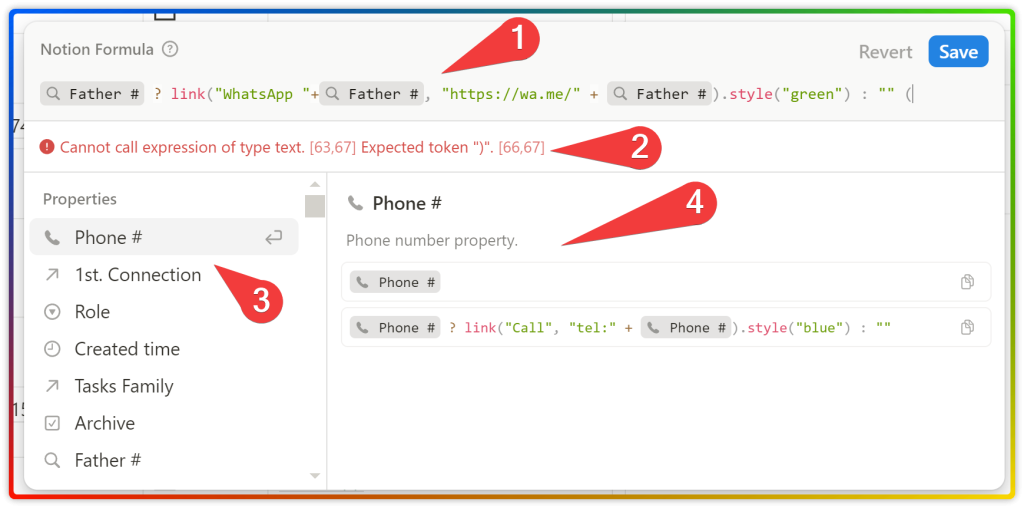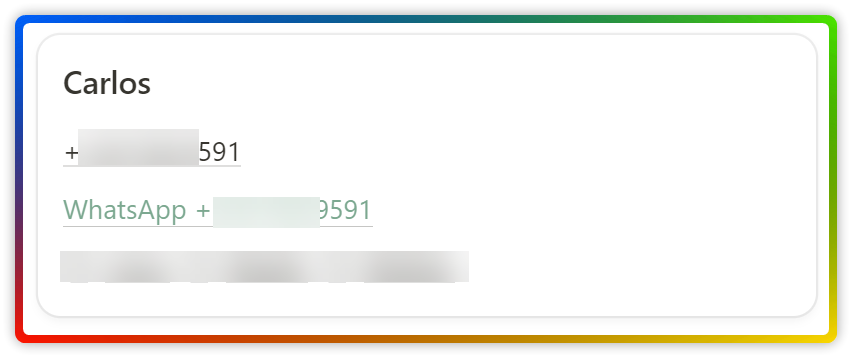Notion Formulas 2.0
- Last Updated on November 26, 2024
On This Page
Using formulas inside a database in Notion unlocks a new level of functionality within your workspace. They allow you to perform calculations, manipulate data, and automate tasks, essentially turning your databases into dynamic mini-programs. If you are a Notion power user or want to take your workspace to a higher level, this reference guide is for you.
Here’s a closer look at what formulas are used for and who benefits from using them:
What Formulas Do:
- Calculations: Perform basic or complex calculations on your database properties. This can include anything from summing up budget figures to calculating deadlines based on durations.
- Data Manipulation: Extract specific information from text properties, format dates or numbers in a particular way, or even combine data from different properties to create new insights.
- Conditional Logic: Use formulas to display information or trigger actions based on specific conditions within your database. Imagine creating a to-do list database that automatically marks tasks as “urgent” if the due date is approaching.
- Automation: Automate repetitive tasks like creating new database entries with pre-populated information or updating property values based on changes in other properties.
Benefits for Different Users:
- Content Creators: Bloggers, YouTubers, writers, and marketers can use formulas to manage editorial calendars, track content performance metrics, or even automate content tagging based on specific criteria.
- Students and Educators: Can utilize formulas to organize study materials, track grades and assignments, or create dynamic flashcards with calculations or conditional formatting. Educators can use formulas to manage student information, track class progress, or create interactive assignments with automated grading features.
- Individual Users: Anyone looking to organize their personal life, from budgeting to habit tracking. Since Notion is an empty canvas, it is up to you to create a simple or complex solution.
- Project Managers: To track project progress, calculate resource allocation, or automate tasks related to scheduling and budgeting.
- Businesses and Teams: For sales pipeline management, inventory control, customer relationship management (CRM), or creating financial dashboards with real-time data updates.
- Small Business Owners: They can use formulas to manage inventory, track sales, and analyze financial data, making business operations smoother.
- Developers and Tech Enthusiasts: With the ability to create complex formulas, they can build sophisticated databases and automate workflows, saving time and reducing manual effort.
In essence, formulas empower anyone who uses Notion to go beyond basic data storage and create intelligent databases that adapt to their specific needs. They offer a way to automate tasks, gain deeper insights from information, and ultimately work more efficiently within your Notion workspace.
On September 16, 2023, Notion Formulas 2.0 was released. This update improved the user experience so that it is now easier to write formulas, debug errors, include more property types in data output, and leverage a larger set of properties and functions.
Notion Formula components
Notion Formula components are the building blocks you use to create formulas in Notion databases. They represent different types of data and operations that can be combined to perform calculations and create dynamic outputs.
For beginners, this topic might seem a bit complex at first, but breaking it down into smaller, manageable parts helps a lot.
When I teach complex ideas, it is my duty to engage your full attention from the beginning so that we can walk the journey together. An effective way to do that is by sharing an analogy so it can act as a bridge between the unfamiliar complex idea and familiar concepts, making the new information easier to understand and remember.
Imagine you’re baking a delicious chocolate cake. You will need a recipe, ingredients, tools, instructions, and an oven. Let’s see how this compares to creating a successful formula in Notion.
- Ingredients: These are like the properties in your Notion database. They represent the individual pieces of information you store, such as the cups of sugar (number property), type of flour (multi-select property), or baking time (date property).
- The Recipe: This is your Notion formula. It outlines the steps and instructions (using functions and operators) for how to combine these ingredients (data points/values) to achieve a specific outcome.
- The Tools: Just like you might use measuring cups, whisks, and mixing bowls for baking, Notion provides various functions (like ifs, join, sum, or text manipulation) that act as your tools within the formula.
- The Instructions: These are like the operators (+, -, &, etc.) in your formula. They tell your “tools” (functions) what actions to perform on the ingredients (data points) and in what order.
- The Chef: This is your formula editor in Notion. It will interpret the recipe, use the tools, and follow the instructions to process the ingredients.
- The Oven: Part of Notion that executes the formula and delivers the result.
Putting it all together:
- You wouldn’t just throw random ingredients (data points) together in a bowl and expect a cake (desired outcome). Similarly, you need to combine the right properties (ingredients) with functions (tools) and operators (instructions) in your formula to achieve the desired result.
- For example, a simple formula to calculate the total cost of ingredients in your recipe might look like this: prop(“Sugar (cups)”) * 0.50 + prop(“Flour (cups)”) * 1.00
- Here, “prop(‘Sugar (cups)’)” and “prop(‘Flour (cups)’)” are like your ingredient references (number of sugar cups and flour cups from your database).
- The multiplication (*) acts as your tool, and the number values (0.50 and 1.00) are the cost of your ingredients.
- The addition (+) operator combines the costs of these ingredients to give you the total cost.
So, just like our chef expertly follows the recipe to create a delicious dish, the formula editor in Notion translates your instructions into clear steps for the system to execute. Now, let’s ditch the kitchen utensils and dive into the actual terminology used for these components in Notion formulas and the formula editor interface.
To enhance your learning experience, I’ve included a companion guide in Notion:
This reference guide provides a list of 122 formula components you could use to help you build custom formulas and enhance your formula creation skills.
Notion formulas terminology
- Input properties are values such as:
- Number or text you add in the formula editor: “Cooking 24 chocolate chip cookies”
- Mathematical constant like pi (π) with an approximation value of 3.14159.
- Or database property tokens: Such as prop(”Number”) which now shows as Number in the new Formulas 2.0 editor.
- Functions are pre-configured formulas you can use to manipulate the input properties. They help automate calculations or perform conditional statements. Let’s say I sold 20 cookies, I could calculate the number of cookies left like this: subtract(24, sold).
- Built-ins are the specific symbols, values, and operators that are pre-programmed into the formula language to perform specific calculations. This could be:
- Math or comparison operators: +, –, %, ==, >
- Boolean values: true, false
- Logical operators: and, or, not
- Ternary operator: ?: which is used for IF STATEMENTs
- Arguments are the specific values or references you provide to a function to tell it what to work with. Example: if(true, “Y”, “F”) where if is the function and true, “Y”, “N” are the arguments.
- Output is the result of your formula applied to all pages in that single database.
- Data types refer to the kind of information a value or property can hold. The formula editor supports seven data types:
- Text, a string of text, and numbers. “I want 24 chocolate cookies”
- Numbers, only numeric characters including decimals or negative values. -3.5
- Boolean, checked or unchecked Checkbox, to represent true or false values.
- Pages, retrieves Notion pages with the Relation property.
- Date, retrieves page date information that can be reformatted.
- People, retrieve names, and emails.
- Lists, known as arrays in Notion can include any of the data types above.
Notion formula editor
Notion’s formula editor is a modal window that appears when you click edit formula. The interface has four visual areas or sections:
- Editing or Input Area 1: This is the main section where you write your formula. It allows you to type property names, functions, operators, and values to create your desired logic. Notion offers features like autocompletion and syntax highlighting to help you write your formula faster and avoid typos. Different colors make it easier to distinguish between properties, functions, operators, and text values.
In Formulas 2.0, you can add inline comments, line breaks shift + enter and indentation for improved readability and organization within your formulas.
- Preview area 2: This section will show empty when the formula works properly or list in red existing errors that need fixing. There are three scenarios when this area will be populated:
- When you click directly on a value or cell for that formula.
- When the result will be the same for all pages. “I like cookies”
- In database view for each page.
- Suggestion area 3: As you type, Notion will show a list of properties, built-ins, and functions based on what you’re currently typing. It’s a valuable tool for discovering new functionalities and building formulas faster, especially when you’re unfamiliar with specific functions.
- Examples area 4: This section depends on and enhances the suggestion area. It provides formula syntax examples that can be copied or used for quick reference.

In the Notion Databases Mastery lesson, I commented that current tools are too rigid and siloed. This is a very simple example of that. My Google Pixel phone has very limited options when editing contact information that can’t be related or costumized.
For the example above, I created a database in Notion for my personal and business contacts. I added a formula property that will open WhatsApp when I clicked the link. For this to work, I told Notion to append the phone number to https://wa.me/ and style the text with green color.
But that’s not it, relations and rollups helped me group contacts by organization or family ties, making it easier to find the information I needed. For example, this solution block lets me see all the parents contact information for each of my children which is useful when planning birthdays.

Notion Formulas 2.0 is a big topic that requires time and practice to master. In future lessons, I will expand on each component and provide real examples so you can embark on your own formula-building journey with confidence.
This lesson is part of the free Mastering Notion: From Zero to Heroe course. I encourage you to check out my other courses to help you become a Notion expert. Your dedication will payoff.
The Notion Essentials Fast Track course has three lessons to help you get familiarized with the tool while putting into practice what you are learning.
The Notion Databases Mastery is one comprehensive guide to help you harness the full potential of Notion’s powerful database functionality.
Wasn’t this lesson great? Do you feel excited to start writing your own formulas after reading this? Join my email list for exclusive access to future lessons, tips, resources, and Notion templates.


